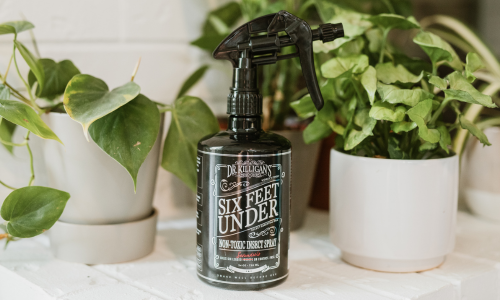While fruit flies and gnats are tiny creatures, both can be extremely annoying and make you feel unwelcome in your own home. How do you know which one is invading your safe place...and how do you get rid of an infestation?
In this post, we will explore the differences between fruit flies and gnats, along with ways to eliminate them from your home and its surroundings. What you find here might surprise you.
Fruit fly vs. gnat appearance
Though seemingly similar in appearance, fruit flies and gnats both have distinguishing features that allow you, if you look ever so closely, to tell them apart. Fruit Flies actually look like a smaller version of a house fly, whereas gnats look like a smaller version of a mosquito. Here are a few other how-to-tell-apart characteristics.

Fruit fly appearance
- Color: Fruit flies appear tan to the human eye, but are actually tan and black—the front portion of their body being tan and the rear portion, black.
- Body Shape: Oval shaped, like a smaller version of the house fly.
- Legs: Very short.
- Antennae: Barely perceptible.
- Eyes: Large, prominent compound eyes that are usually red in color, though they can also be brown or black.
Gnat appearance
- Color: Gnats are dark brown.
- Body Shape: They have long and thin bodies. Think of it a mix between a weasel (which has a long body) and a giraffe (with its long legs), but with wings. On second thought, just think of a tiny bug.
- Legs: Long.
- Antennae: Lengthy.
- Eyes: Barely detectable.
Why fruit flies and gnats swarm
Gnats swarm together to reproduce. You may see a cluster of male gnats in a sunlit area when you’re on an evening stroll or hovering over a ripple in a stream or a fencepost. Swarm "markers" include objects that contrast with their surrounding landscape, which make it easier for the females to see their male counterparts. Fruit flies, on the other hand, swarm to eat. In their attraction to sweet, rotting fruits, fruit flies gather to feast. You may see a swarm of fruit flies hovering over brown-spotted bananas, sink drain, garbage disposal, mop bucket, or even a damp sponge.
Fruit flies vs. gnats and overcoming them
If you are dealing with a fruit fly infestation (or a gnats infestation), Dr. Killigan is here to help. Fruit flies will not simply disappear on their own. In fact, they’ll do quite the opposite, laying up to 2,000 eggs in their short 15-day lifespan (if they make it that long). These eggs, mind you, become egg-laying adult females themselves within two days of birth. Purchase Dr. Killigan's Sweet Surrender, with its powerful handcrafted blend of vinegar, sucrose, and citrus, and naturally attract and kill the common fruit fly. Protect that produce and solve all of your fruit fly afflictions.  I would also purchase Dr. Killigan’s Six Feet Under, a fruit fly spray that is safe to use in your kitchen. Wipe out the bottom of your fruit bowls with this kill-on-contact spray. Use this non-toxic spray to clean the inside of your garbage can. Spray, rest, repeat. Let Dr. Killigan do the dirty work.
I would also purchase Dr. Killigan’s Six Feet Under, a fruit fly spray that is safe to use in your kitchen. Wipe out the bottom of your fruit bowls with this kill-on-contact spray. Use this non-toxic spray to clean the inside of your garbage can. Spray, rest, repeat. Let Dr. Killigan do the dirty work.
For gnats, I offer up useful information. Close your mouth when you’re on a bike ride. If you speed through a swarm of them, you don’t really want to choke down a few dozen. In your backyard, let them be. They don’t bite and they’re not attracted to you. They’re most likely performing their mating dance. If anything, take a slow sip of your cool drink and be thankful that you don’t have to bounce up and down to get someone’s attention and that you’re going to live more than 7 days.
If you find that the gnats haphazardly make their way indoors (remember that they’re not great fliers), here’s a simple DIY gnats trap to get rid of them:
Mix half a cup of warm water with two tablespoons of apple cider vinegar, one tablespoon of sugar, and about six drops of liquid dish soap. Pour this into a shallow bowl, mix, and go about your business. Gnats, like fruit flies, will die (literally) for sugar. They’re lured in for a drink and then stuck with the dish soap. Goodbye, you little winged invaders!










